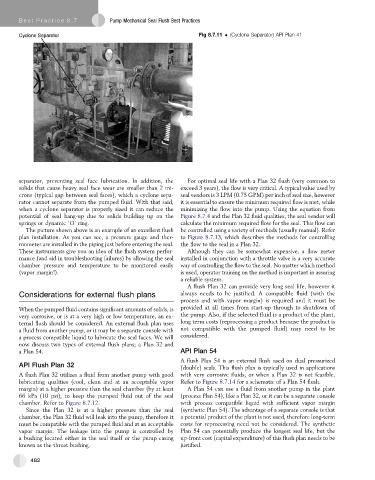Page 511 - Subyek Teknik Mesin - Forsthoffers Best Practice Handbook for Rotating Machinery by William E Forsthoffer
P. 511
Be st Practice 8 .7 Pump Mechanical Seal Flush Best Practices
Fig 8.7.11 (Cyclone Separator) API Plan 41
separator, preventing seal face lubrication. In addition, the For optimal seal life with a Plan 32 flush (very common to
solids that cause heavy seal face wear are smaller than 2 mi- exceed 3 years), the flow is very critical. A typical value used by
crons (typical gap between seal faces), which a cyclone sepa- seal vendors is 3 LPM (0.75 GPM) per inch of seal size, however
rator cannot separate from the pumped fluid. With that said, it is essential to ensure the minimum required flow is met, while
when a cyclone separator is properly sized it can reduce the minimizing the flow into the pump. Using the equation from
potential of seal hang-up due to solids building up on the Figure 8.7.4 and the Plan 32 fluid qualities, the seal vendor will
springs or dynamic ‘O’ ring. calculate the minimum required flow for the seal. This flow can
The picture shown above is an example of an excellent flush be controlled using a variety of methods (usually manual). Refer
plan installation. As you can see, a pressure gauge and ther- to Figure 8.7.13, which describes the methods for controlling
mometer are installed in the piping just before entering the seal. the flow to the seal in a Plan 32.
These instruments give you an idea of the flush system perfor- Although they can be somewhat expensive, a flow meter
mance (and aid in troubleshooting failures) by allowing the seal installed in conjunction with a throttle valve is a very accurate
chamber pressure and temperature to be monitored easily way of controlling the flow to the seal. No matter which method
(vapor margin!). is used, operator training on the method is important in assuring
a reliable system.
A flush Plan 32 can provide very long seal life, however it
Considerations for external flush plans always needs to be justified. A compatible fluid (with the
process and with vapor margin) is required and it must be
When the pumped fluid contains significant amounts of solids, is provided at all times from start-up through to shutdown of
very corrosive, or is at a very high or low temperature, an ex- the pump. Also, if the selected fluid is a product of the plant,
ternal flush should be considered. An external flush plan uses long term costs (reprocessing a product because the product is
a fluid from another pump, or it may be a separate console with not compatible with the pumped fluid) may need to be
a process compatible liquid to lubricate the seal faces. We will considered.
now discuss two types of external flush plans; a Plan 32 and
a Plan 54. API Plan 54
A flush Plan 54 is an external flush used on dual pressurized
API Flush Plan 32 (double) seals. This flush plan is typically used in applications
A flush Plan 32 utilizes a fluid from another pump with good with very corrosive fluids, or when a Plan 32 is not feasible.
lubricating qualities (cool, clean and at an acceptable vapor Refer to Figure 8.7.14 for a schematic of a Plan 54 flush.
margin) at a higher pressure than the seal chamber (by at least A Plan 54 can use a fluid from another pump in the plant
66 kPa (10 psi), to keep the pumped fluid out of the seal (process Plan 54), like a Plan 32, or it can be a separate console
chamber. Refer to Figure 8.7.12. with process compatible liquid with sufficient vapor margin
Since the Plan 32 is at a higher pressure than the seal (synthetic Plan 54). The advantage of a separate console is that
chamber, the Plan 32 fluid will leak into the pump, therefore it a potential product of the plant is not used, therefore long-term
must be compatible with the pumped fluid and at an acceptable costs for reprocessing need not be considered. The synthetic
vapor margin. The leakage into the pump is controlled by Plan 54 can potentially produce the longest seal life, but the
a bushing located either in the seal itself or the pump casing up-front cost (capital expenditure) of this flush plan needs to be
known as the throat bushing. justified.
482

